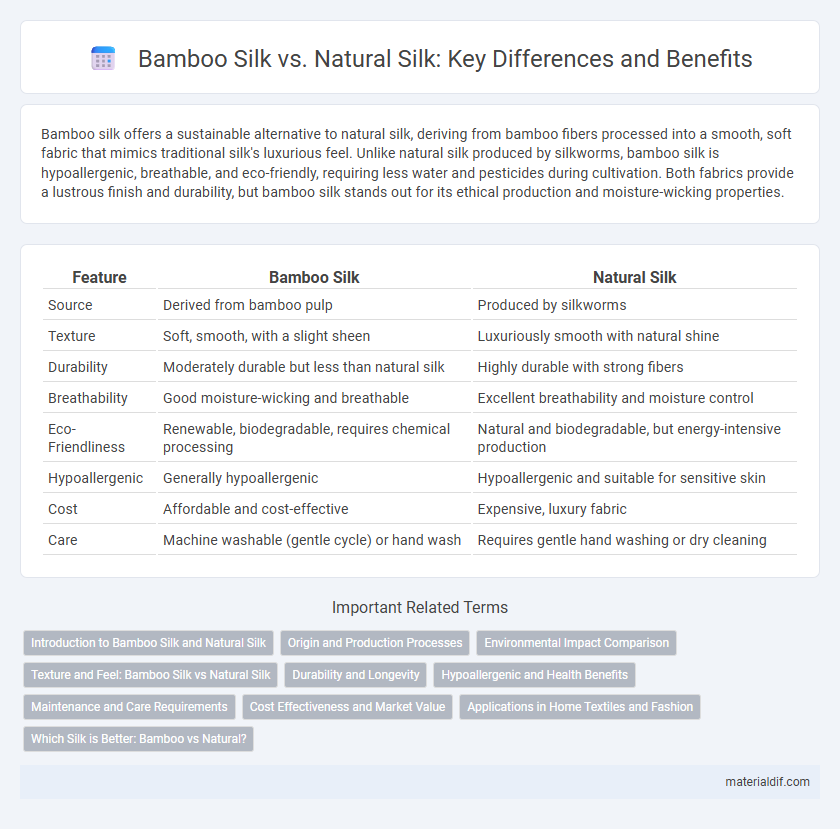Bamboo silk offers a sustainable alternative to natural silk, deriving from bamboo fibers processed into a smooth, soft fabric that mimics traditional silk's luxurious feel. Unlike natural silk produced by silkworms, bamboo silk is hypoallergenic, breathable, and eco-friendly, requiring less water and pesticides during cultivation. Both fabrics provide a lustrous finish and durability, but bamboo silk stands out for its ethical production and moisture-wicking properties.
Table of Comparison
| Feature | Bamboo Silk | Natural Silk |
|---|---|---|
| Source | Derived from bamboo pulp | Produced by silkworms |
| Texture | Soft, smooth, with a slight sheen | Luxuriously smooth with natural shine |
| Durability | Moderately durable but less than natural silk | Highly durable with strong fibers |
| Breathability | Good moisture-wicking and breathable | Excellent breathability and moisture control |
| Eco-Friendliness | Renewable, biodegradable, requires chemical processing | Natural and biodegradable, but energy-intensive production |
| Hypoallergenic | Generally hypoallergenic | Hypoallergenic and suitable for sensitive skin |
| Cost | Affordable and cost-effective | Expensive, luxury fabric |
| Care | Machine washable (gentle cycle) or hand wash | Requires gentle hand washing or dry cleaning |
Introduction to Bamboo Silk and Natural Silk
Bamboo silk is a sustainable alternative made from cellulose fibers extracted from bamboo plants, known for its softness, breathability, and eco-friendly production process. Natural silk, produced by silkworms, offers a luxurious texture and strong fiber quality but involves resource-intensive cultivation and harvesting. Both materials provide a smooth and lustrous finish, yet bamboo silk stands out for its renewable origin and lower environmental impact compared to traditional natural silk.
Origin and Production Processes
Bamboo silk is derived from bamboo cellulose through a chemical process that converts the plant fibers into viscose or rayon, whereas natural silk is produced by silkworms spinning cocoons. The production of bamboo silk involves breaking down bamboo pulp with solvents, followed by regeneration of the fibers into yarn, contrasting with the traditional sericulture and hand-reeling techniques used for natural silk extraction. Originating from fast-growing bamboo plants, bamboo silk offers a sustainable alternative to natural silk, which depends on the labor-intensive and time-consuming cultivation of silkworms.
Environmental Impact Comparison
Bamboo silk production generates significantly lower carbon emissions and consumes less water compared to natural silk, making it a more sustainable textile choice. Unlike natural silk, which relies on silkworm cultivation and involves high resource usage and pesticide application, bamboo silk is derived from fast-growing bamboo plants that require minimal fertilizers and pesticides. This reduced environmental footprint contributes to bamboo silk's appeal as an eco-friendly alternative in the textile industry.
Texture and Feel: Bamboo Silk vs Natural Silk
Bamboo silk offers a smooth and soft texture with a slightly matte finish, providing a breathable and hypoallergenic feel ideal for sensitive skin. Natural silk has a luxurious, glossy sheen and a smooth, cool touch that feels lightweight and elegant against the skin. Both fibers provide distinct tactile experiences, with bamboo silk emphasizing comfort and sustainability, while natural silk highlights opulence and traditional softness.
Durability and Longevity
Bamboo silk exhibits superior durability compared to natural silk due to its higher tensile strength and resistance to wear and tear, making it ideal for everyday use. The longevity of bamboo silk is enhanced by its natural antimicrobial properties that reduce fabric degradation and maintain freshness over time. In contrast, natural silk requires more delicate care to prevent damage, resulting in a shorter lifespan under similar conditions.
Hypoallergenic and Health Benefits
Bamboo silk is naturally hypoallergenic, making it ideal for sensitive skin and reducing the risk of allergic reactions compared to natural silk, which may cause irritation in some individuals. The antibacterial properties of bamboo fiber inhibit dust mites and mold growth, promoting a healthier sleeping environment. Bamboo silk also offers moisture-wicking benefits that help regulate body temperature and prevent skin discomfort linked to sweat and bacteria.
Maintenance and Care Requirements
Bamboo silk requires gentle washing with cold water and mild detergent to maintain its softness and sheen, while natural silk demands even more delicate care, often necessitating hand washing or dry cleaning to preserve its fibers. Both fabrics are sensitive to harsh chemicals and high temperatures, which can cause damage or color fading. Proper air drying away from direct sunlight is crucial for preventing shrinkage and maintaining the longevity of bamboo silk and natural silk garments.
Cost Effectiveness and Market Value
Bamboo silk offers a more cost-effective alternative to natural silk due to its lower production costs and faster renewable resource cycle, making it accessible for budget-conscious consumers and manufacturers. While natural silk commands a higher market value driven by its luxury appeal and traditional harvesting methods, bamboo silk is gaining traction for its sustainable properties and affordability. The growing demand for eco-friendly textiles enhances bamboo silk's market potential, positioning it as a competitive option within the textile industry.
Applications in Home Textiles and Fashion
Bamboo silk offers a sustainable alternative to natural silk with comparable softness and sheen, making it popular in home textiles like bedding, curtains, and upholstery where eco-friendly materials are prioritized. Its moisture-wicking and breathable properties enhance comfort in fashion applications such as scarves, blouses, and dresses, while its hypoallergenic nature appeals to sensitive skin consumers. Natural silk remains preferred for luxury fashion and high-end home decor due to its unmatched luster and strength, but bamboo silk increasingly captures market share by combining environmental benefits with versatile usability.
Which Silk is Better: Bamboo vs Natural?
Bamboo silk offers eco-friendly benefits with its sustainable cultivation and biodegradable properties, making it a popular alternative to traditional natural silk, which is prized for its luxurious softness and durability derived from silkworm fibers. Bamboo silk tends to be more breathable and hypoallergenic, ideal for sensitive skin, while natural silk excels in thermal regulation and long-lasting quality. Consumers seeking environmentally conscious fabrics may prefer bamboo silk, whereas those valuing traditional luxury and texture often choose natural silk.
Bamboo silk vs Natural silk Infographic

 materialdif.com
materialdif.com